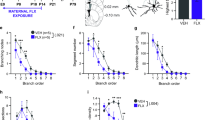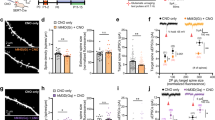Abstract
The discovery that a common polymorphism (5-HTTLPR, short variant) in the human serotonin transporter gene (SLC6A4) can influence personality traits and increase the risk for depression in adulthood has led to the hypothesis that a relative increase in the extracellular levels of serotonin (5-HT) during development could be critical for the establishment of brain circuits. Consistent with this idea, a large body of data demonstrate that 5-HT is a strong neurodevelopmental signal that can modulate a wide variety of cellular processes. In humans, serotonergic fibers appear in the developing cortex as early as the 10th gestational week, a period of intense neuronal migration. In this study we hypothesized that an excess of 5-HT could affect embryonic cortical interneuron migration. Using time-lapse videometry to monitor the migration of interneurons in embryonic mouse cortical slices, we discovered that the application of 5-HT decreased interneuron migration in a reversible and dose-dependent manner. We next found that 5-HT6 receptors were expressed in cortical interneurons and that 5-HT6 receptor activation decreased interneuron migration, whereas 5-HT6 receptor blockade prevented the migratory effects induced by 5-HT. Finally, we observed that interneurons were abnormally distributed in the cerebral cortex of serotonin transporter gene (Slc6a4) knockout mice that have high levels of extracellular 5-HT. These results shed new light on the neurodevelopmental alterations caused by an excess of 5-HT during the embryonic period and contribute to a better understanding of the cellular processes that could be modulated by genetically controlled differences in human 5-HT homeostasis.
This is a preview of subscription content, access via your institution
Access options
Subscribe to this journal
Receive 12 print issues and online access
$259.00 per year
only $21.58 per issue
Buy this article
- Purchase on Springer Link
- Instant access to full article PDF
Prices may be subject to local taxes which are calculated during checkout







Similar content being viewed by others
References
Canli T, Lesch KP . Long story short: the serotonin transporter in emotion regulation and social cognition. Nat Neurosci 2007; 10: 1103–1109.
Caspi A, Sugden K, Moffitt TE, Taylor A, Craig IW, Harrington H et al. Influence of life stress on depression: moderation by a polymorphism in the 5-HTT gene. Science 2003; 301: 386–389.
Kendler KS, Kuhn JW, Vittum J, Prescott CA, Riley B . The interaction of stressful life events and a serotonin transporter polymorphism in the prediction of episodes of major depression: a replication. Arch Gen Psychiatry 2005; 62: 529–535.
Hariri AR, Holmes A . Genetics of emotional regulation: the role of the serotonin transporter in neural function. Trends Cogn Sci 2006; 10: 182–191.
Munafo MR, Brown SM, Hariri AR . Serotonin transporter (5-HTTLPR) genotype and amygdala activation: a meta-analysis. Biol Psychiatry 2008; 63: 852–857.
Pezawas L, Meyer-Lindenberg A, Drabant EM, Verchinski BA, Munoz KE, Kolachana BS et al. 5-HTTLPR polymorphism impacts human cingulate-amygdala interactions: a genetic susceptibility mechanism for depression. Nat Neurosci 2005; 8: 828–834.
Izquierdo A, Newman TK, Higley JD, Murray EA . Genetic modulation of cognitive flexibility and socioemotional behavior in rhesus monkeys. Proc Natl Acad Sci USA 2007; 104: 14128–14133.
Bennett AJ, Lesch KP, Heils A, Long JC, Lorenz JG, Shoaf SE et al. Early experience and serotonin transporter gene variation interact to influence primate CNS function. Mol Psychiatry 2002; 7: 118–122.
Suomi SJ . Risk, resilience, and gene x environment interactions in rhesus monkeys. Ann N Y Acad Sci 2006; 1094: 52–62.
Champoux M, Bennett A, Shannon C, Higley JD, Lesch KP, Suomi SJ . Serotonin transporter gene polymorphism, differential early rearing, and behavior in rhesus monkey neonates. Mol Psychiatry 2002; 7: 1058–1063.
Mathews TA, Fedele DE, Coppelli FM, Avila AM, Murphy DL, Andrews AM . Gene dose-dependent alterations in extraneuronal serotonin but not dopamine in mice with reduced serotonin transporter expression. J Neurosci Methods 2004; 140: 169–181.
Murphy DL, Lesch KP . Targeting the murine serotonin transporter: insights into human neurobiology. Nat Rev Neurosci 2008; 9: 85–96.
Vitalis T, Parnavelas JG . The role of serotonin in early cortical development. Dev Neurosci 2003; 25: 245–256.
Gaspar P, Cases O, Maroteaux L . The developmental role of serotonin: news from mouse molecular genetics. Nat Rev Neurosci 2003; 4: 1002–1012.
Wellman CL, Izquierdo A, Garrett JE, Martin KP, Carroll J, Millstein R et al. Impaired stress-coping and fear extinction and abnormal corticolimbic morphology in serotonin transporter knock-out mice. J Neurosci 2007; 27: 684–691.
Altamura C, Dell’Acqua ML, Moessner R, Murphy DL, Lesch KP, Persico AM . Altered neocortical cell density and layer thickness in serotonin transporter knockout mice: a quantitation study. Cereb Cortex 2007; 17: 1394–1401.
Todtenkopf MS, Vincent SL, Benes FM . A cross-study meta-analysis and three-dimensional comparison of cell counting in the anterior cingulate cortex of schizophrenic and bipolar brain. Schizophr Res 2005; 73: 79–89.
Lewis DA, Hashimoto T, Volk DW . Cortical inhibitory neurons and schizophrenia. Nat Rev Neurosci 2005; 6: 312–324.
Vitalis T, Cases O, Passemard S, Callebert J, Parnavelas JG . Embryonic depletion of serotonin affects cortical development. Eur J Neurosci 2007; 26: 331–344.
Verney C, Lebrand C, Gaspar P . Changing distribution of monoaminergic markers in the developing human cerebral cortex with special emphasis on the serotonin transporter. Anat Rec 2002; 267: 87–93.
Wallace JA, Lauder JM . Development of the serotonergic system in the rat embryo: an immunocytochemical study. Brain Res Bull 1983; 10: 459–479.
Lopez-Bendito G, Sturgess K, Erdelyi F, Szabo G, Molnar Z, Paulsen O . Preferential origin and layer destination of GAD65-GFP cortical interneurons. Cereb Cortex 2004; 14: 1122–1133.
Bengel D, Murphy DL, Andrews AM, Wichems CH, Feltner D, Heils A et al. Altered brain serotonin homeostasis and locomotor insensitivity to 3, 4-methylenedioxymethamphetamine (‘Ecstasy’) in serotonin transporter-deficient mice. Mol Pharmacol 1998; 53: 649–655.
Bonnin A, Torii M, Wang L, Rakic P, Levitt P . Serotonin modulates the response of embryonic thalamocortical axons to netrin-1. Nat Neurosci 2007; 10: 588–597.
Yokota Y, Gashghaei HT, Han C, Watson H, Campbell KJ, Anton ES . Radial glial dependent and independent dynamics of interneuronal migration in the developing cerebral cortex. PLoS ONE 2007; 2: e794.
Mattsson C, Sonesson C, Sandahl A, Greiner HE, Gassen M, Plaschke J et al. 2-Alkyl-3-(1,2,3,6-tetrahydropyridin-4-yl)-1H-indoles as novel 5-HT6 receptor agonists. Bioorg Med Chem Lett 2005; 15: 4230–4234.
Hirst WD, Minton JA, Bromidge SM, Moss SF, Latter AJ, Riley G et al. Characterization of [(125)I]-SB-258585 binding to human recombinant and native 5-HT(6) receptors in rat, pig and human brain tissue. Br J Pharmacol 2000; 130: 1597–1605.
Bachy A, Heaulme M, Giudice A, Michaud JC, Lefevre IA, Souilhac J et al. SR 57227A: a potent and selective agonist at central and peripheral 5-HT3 receptors in vitro and in vivo. Eur J Pharmacol 1993; 237: 299–309.
Kumada T, Lakshmana MK, Komuro H . Reversal of neuronal migration in a mouse model of fetal alcohol syndrome by controlling second-messenger signalings. J Neurosci 2006; 26: 742–756.
Persico AM, Baldi A, Dell’Acqua ML, Moessner R, Murphy DL, Lesch KP et al. Reduced programmed cell death in brains of serotonin transporter knockout mice. Neuroreport 2003; 14: 341–344.
Boehme SA, Lio FM, Sikora L, Pandit TS, Lavrador K, Rao SP et al. Cutting edge: serotonin is a chemotactic factor for eosinophils and functions additively with eotaxin. J Immunol 2004; 173: 3599–3603.
Day RM, Agyeman AS, Segel MJ, Chevere RD, Angelosanto JM, Suzuki YJ et al. Serotonin induces pulmonary artery smooth muscle cell migration. Biochem Pharmacol 2006; 71: 386–397.
Matsusaka S, Wakabayashi I . 5-Hydroxytryptamine as a potent migration enhancer of human aortic endothelial cells. FEBS Lett 2005; 579: 6721–6725.
Moiseiwitsch JR, Lauder JM . Serotonin regulates mouse cranial neural crest migration. Proc Natl Acad Sci USA 1995; 92: 7182–7186.
Kindt KS, Tam T, Whiteman S, Schafer WR . Serotonin promotes G(o)-dependent neuronal migration in Caenorhabditis elegans. Curr Biol 2002; 12: 1738–1747.
Lopez-Bendito G, Cautinat A, Sanchez JA, Bielle F, Flames N, Garratt AN et al. Tangential neuronal migration controls axon guidance: a role for neuregulin-1 in thalamocortical axon navigation. Cell 2006; 125: 127–142.
Cases O, Vitalis T, Seif I, De Maeyer E, Sotelo C, Gaspar P . Lack of barrels in the somatosensory cortex of monoamine oxidase A-deficient mice: role of a serotonin excess during the critical period. Neuron 1996; 16: 297–307.
Leonardo ED, Hen R . Anxiety as a developmental disorder. Neuropsychopharmacology 2008; 33: 134–140.
Bonnin A, Peng W, Hewlett W, Levitt P . Expression mapping of 5-HT1 serotonin receptor subtypes during fetal and early postnatal mouse forebrain development. Neuroscience 2006; 141: 781–794.
Grimaldi B, Bonnin A, Fillion MP, Ruat M, Traiffort E, Fillion G . Characterization of 5-ht6 receptor and expression of 5-ht6 mRNA in the rat brain during ontogenetic development. Naunyn Schmiedebergs Arch Pharmacol 1998; 357: 393–400.
Bonasera SJ, Chu HM, Brennan TJ, Tecott LH . A null mutation of the serotonin 6 receptor alters acute responses to ethanol. Neuropsychopharmacology 2006; 31: 1801–1813.
Woolley ML, Marsden CA, Fone KC . 5-ht6 receptors. Curr Drug Targets CNS Neurol Disord 2004; 3: 59–79.
Nishiyama M, Hoshino A, Tsai L, Henley JR, Goshima Y, Tessier-Lavigne M et al. Cyclic AMP/GMP-dependent modulation of Ca2+ channels sets the polarity of nerve growth-cone turning. Nature 2003; 423: 990–995.
Cuzon VC, Yeh PW, Yanagawa Y, Obata K, Yeh HH . Ethanol consumption during early pregnancy alters the disposition of tangentially migrating GABAergic interneurons in the fetal cortex. J Neurosci 2008; 28: 1854–1864.
Yozu M, Tabata H, Konig N, Nakajima K . Migratory behavior of presumptive interneurons is affected by AMPA receptor activation in slice cultures of embryonic mouse neocortex. Dev Neurosci 2008; 30: 105–116.
Lebrand C, Cases O, Wehrle R, Blakely RD, Edwards RH, Gaspar P . Transient developmental expression of monoamine transporters in the rodent forebrain. J Comp Neurol 1998; 401: 506–524.
Bruning G, Liangos O, Baumgarten HG . Prenatal development of the serotonin transporter in mouse brain. Cell Tissue Res 1997; 289: 211–221.
Bruns D, Riedel D, Klingauf J, Jahn R . Quantal release of serotonin. Neuron 2000; 28: 205–220.
Clements JD . Transmitter timecourse in the synaptic cleft: its role in central synaptic function. Trends Neurosci 1996; 19: 163–171.
Acknowledgements
We thank C Aubry, B Pastori, P Marin and B King for technical assistance. This work was supported by a Swiss National Foundation grant 3100A0-116496 and De Reuter Foundation to A.G.D. and Swiss National Foundation grant 3100A0-116496, the Eagle Foundation and by the European Community Grant Promemoria No. 512012-2005 to J.Z.K.
Author information
Authors and Affiliations
Corresponding author
Additional information
Supplementary Information accompanies the paper on the Molecular Psychiatry website (http://www.nature.com/mp)
Rights and permissions
About this article
Cite this article
Riccio, O., Potter, G., Walzer, C. et al. Excess of serotonin affects embryonic interneuron migration through activation of the serotonin receptor 6. Mol Psychiatry 14, 280–290 (2009). https://doi.org/10.1038/mp.2008.89
Received:
Revised:
Accepted:
Published:
Issue Date:
DOI: https://doi.org/10.1038/mp.2008.89
Keywords
This article is cited by
-
The Roles of Serotonin in Neuropsychiatric Disorders
Cellular and Molecular Neurobiology (2022)
-
Serotonin deficiency induced after brain maturation rescues consequences of early life adversity
Scientific Reports (2021)
-
Neurodevelopmental and behavioral consequences of perinatal exposure to the HIV drug efavirenz in a rodent model
Translational Psychiatry (2019)
-
Genetically driven brain serotonin deficiency facilitates panic-like escape behavior in mice
Translational Psychiatry (2017)
-
The Placenta as a Mediator of Stress Effects on Neurodevelopmental Reprogramming
Neuropsychopharmacology (2016)



